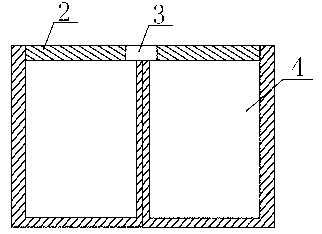Culture method for rice seedlings
A cultivation method and seedling technology are applied in the field of cultivating rice by using a root-splitting cultivation device, and can solve the problems of inaccurate experimental results, unreasonable structure of the sub-cultivation device, and inconvenient operation.
- Summary
- Abstract
- Description
- Claims
- Application Information
AI Technical Summary
Problems solved by technology
Method used
Image
Examples
Embodiment 1
[0060]A method for cultivating rice seedlings. The rice seedlings are cultivated using a split-root cultivation device. The split-root cultivation device includes two symmetrically arranged cultivation pots 4, a cultivation plate 2 and a cover plate 1. The cultivation pot 4 is a cuboid with an open upper end. , the sides of the two cultivation bowls 4 are docked, and the height of the docked sides is 2.0 cm lower than the height of the remaining sides. Above the opening ends of the two cultivation bowls 4, a plurality of cover plates 1 and cultivation plates 2 perpendicular to the low sides are arranged. The plate 1 and the cultivation plate 2 are arranged alternately, and the middle part of the cultivation plate 2 is provided with a culture hole 3, the aperture of the culture hole 3 is 2.5 cm, and the culture hole 3 is arranged above the butt joint surface of the two culture bowls 4;
[0061] The length of the cover plate 1 is equal to the sum of the widths of the two culture ...
Embodiment 2
[0077] A method for cultivating rice seedlings. The rice seedlings are cultivated using a split-root cultivation device. The split-root cultivation device includes two symmetrically arranged cultivation pots 4, a cultivation plate 2 and a cover plate 1. The cultivation pot 4 is a cuboid with an open upper end. , the sides of the two cultivation bowls 4 are docked, and the height of the docked sides is 2.0 cm lower than the height of the remaining sides. Above the opening ends of the two cultivation bowls 4, a plurality of cover plates 1 and cultivation plates 2 perpendicular to the low sides are arranged. The plate 1 and the cultivation plate 2 are arranged alternately, and the middle part of the cultivation plate 2 is provided with a culture hole 3, the aperture of the culture hole 3 is 3.5 cm, and the culture hole 3 is arranged above the docking surface of the two culture bowls 4;
[0078] The length of the cover plate 1 is equal to the sum of the widths of the two culture bo...
Embodiment 3
[0094] A method for cultivating rice seedlings. The rice seedlings are cultivated using a split-root cultivation device. The split-root cultivation device includes two symmetrically arranged cultivation pots 4, a cultivation plate 2 and a cover plate 1. The cultivation pot 4 is a cuboid with an open upper end. , the sides of the two cultivation bowls 4 are docked, and the height of the docked sides is 2.0 cm lower than the height of the remaining sides. Above the opening ends of the two cultivation bowls 4, a plurality of cover plates 1 and cultivation plates 2 perpendicular to the low sides are arranged. The plate 1 and the cultivation plate 2 are arranged alternately, and the middle part of the cultivation plate 2 is provided with a culture hole 3, the aperture of the culture hole 3 is 4.0 cm, and the culture hole 3 is arranged above the docking surface of the two culture bowls 4;
[0095] The length of the cover plate 1 is equal to the sum of the widths of the two culture bo...
PUM
 Login to View More
Login to View More Abstract
Description
Claims
Application Information
 Login to View More
Login to View More - R&D
- Intellectual Property
- Life Sciences
- Materials
- Tech Scout
- Unparalleled Data Quality
- Higher Quality Content
- 60% Fewer Hallucinations
Browse by: Latest US Patents, China's latest patents, Technical Efficacy Thesaurus, Application Domain, Technology Topic, Popular Technical Reports.
© 2025 PatSnap. All rights reserved.Legal|Privacy policy|Modern Slavery Act Transparency Statement|Sitemap|About US| Contact US: help@patsnap.com


